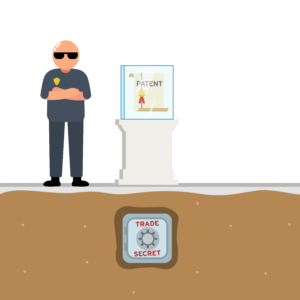
If you have successfully invented something new, unique, and non-obvious, congratulations! However, you’ve still got a long road to go before you see your product doing well commercially. Right now, you may be facing a fork in that road as you arrive at the next immediate step: patents vs trade secrets.
Which is the best way to protect your idea before you enter the market?
Your invention is a puzzle composed of many pieces of intellectual property: the proposed design, function, iterations, logic, and the targeted problem. Understanding these components is what’s necessary for anyone to truly replicate your unique creations – which is why it’s important they stay protected under your name. There are essentially two ways to protect information: safety in disclosure, or safety in secrecy.
Safety in Disclosure – A patent is a type of intellectual property that gives the inventor the exclusive right to his or her invention through legal authority in exchange for full enablement. Meaning, the inventor must disclose enough information for others who are skilled in the relevant art to comprehend and possibly be able to replicate the invention. Patents can be seen as a transparent case around your artwork in a museum. The museum guards your artwork so long as it can be viewed by the public. Legally, the case is impenetrable: any infringement on your patent can warrant a civil lawsuit. However, the case opens after a set term (usually 14-20 years, based on your invention,) and the rights to manufacture your work enter public domain.
Safety in Secrecy – A trade secret is a form of intellectual property in the form of a formula, process, code, pattern, commercial method, or compilation of information that a business keeps out of public access in order to secure an invention on the market for as long as possible – on its own terms. However, a trade secret is only as protective as you make it. Since it is independently secured, nothing stops another party from decoding your invention and uncovering your key to success. Trade secrets are the uninsured, unknown lockbox that you keep in your own personal hiding spot. If that hiding spot is too good to crack, then your invention is indefinitely secured by you. However, if another business is able to analyze, dissect, and “reverse engineer” your invention, there’s nothing excluding that third party from profiting on what they discover in the lockbox.
Before you choose a direction to follow, consider that road may not be truly forked at all. Here at nth Solutions, we live the patents vs. trade secrets debate every day. We discuss the pros and cons of each, and in working with you, find your best answer. Think of it as the classic adage; why put all your eggs in one basket? A smart company knows that every different invention has a different best fit, and the only way to truly secure it is by always considering both options and possibly, combining the two!
As we mentioned before, your invention is a puzzle composed of many pieces of intellectual property, which allows you to leverage different types of protection. One of nth’s flagship products, The LeakAlertor® 6000, is a perfect example of this philosophy. Our company showcases multiple issued patents on the technology, function, and design that went into our product before it could enter the market. If you want to see what it can do and essentially how it does it, it’s all in that transparent case, available for viewing. However, there are some aspects – specific algorithms, years of trials and documentation, and an abundance of research and experience – that are very much secured in our own lockboxes.
We’ve faced the fork countless times, and every time, we find that the key to success is knowing and evaluating both branches of the road concurrently. It doesn’t have to be an exclusive decision. After all, your invention is not a product of a single intellectual component, so it only makes sense to explore options for protection that reflect its complexities with due diligence.
